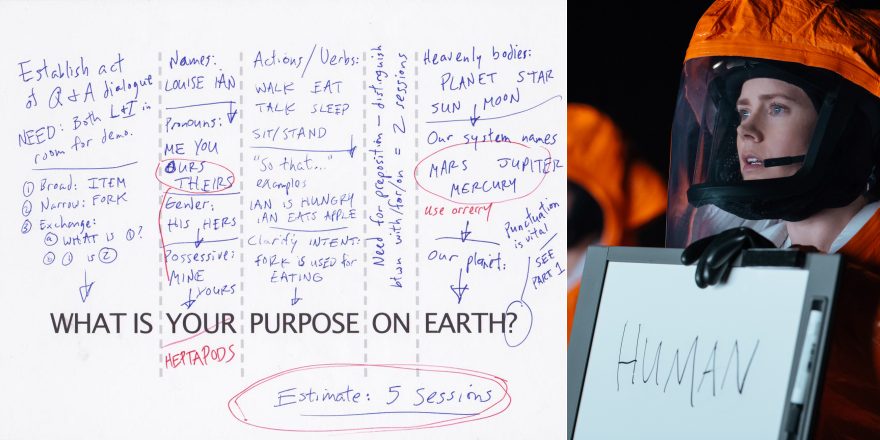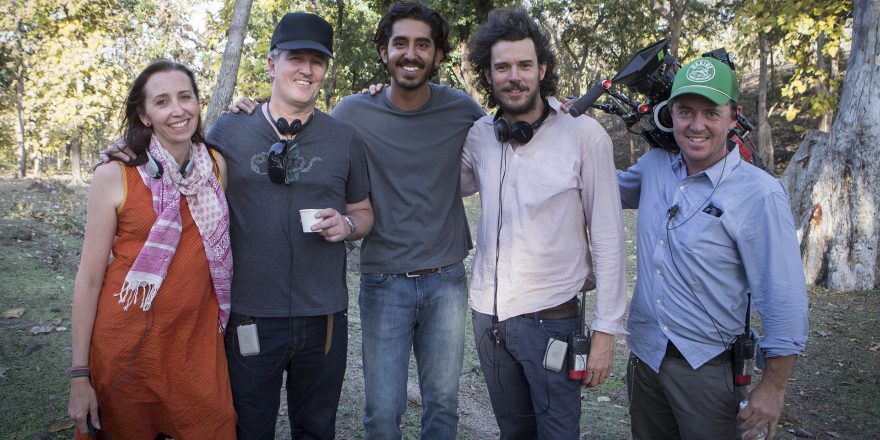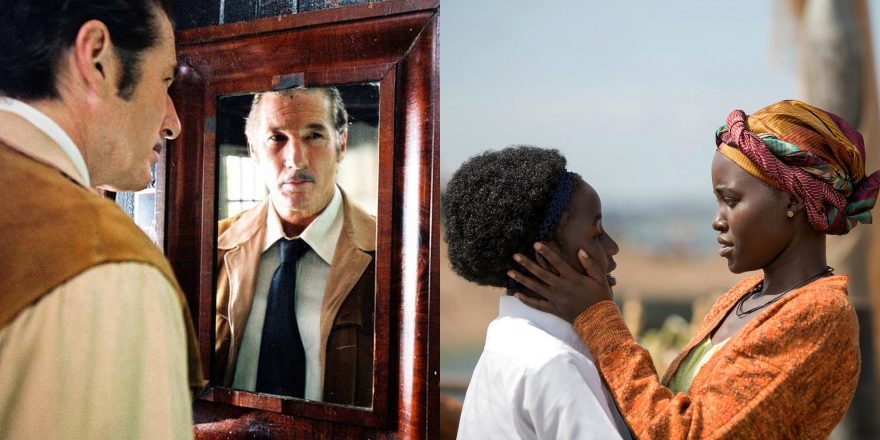Over the festive break, Talkhouse Film is revisiting some of its most read (or listened to) pieces of the year, including this one. Happy holidays! – N.D.
My mother read to me when I was young, like mothers do. But instead of Dr. Seuss or Betsy Byars, it was Heinlein. Bradbury. Asimov. Stories of new worlds, new ideas, and possibilities for the future. It was a key ingredient in my childhood, but one I learned to keep quiet in my hometown in Oklahoma where, occasionally, adults used air quotes when saying the word science.
Nevertheless, science fiction was my first literary love, and after years away from the genre, the author who brought me back was Ted Chiang. Ted is one of those rare finds in that he writes compelling fiction that is both intellectually invigorating and emotionally true. He can educate me about theoretical physics and then leave me sobbing into my couch cushion. And while so much of his work is built purely as literature, when I think about adapting a story I don’t dwell on how cinematic the source material is but rather how it makes me feel.
“Story of Your Life” stuck with me. It shadowed me by day and hovered over me when I slept. I knew I wanted to translate to screen, but I had no idea how, or with whom. I just knew I had to find a way.
At this point in my career, I had written 13 spec screenplays. Six of those spec features were science fiction. The only horror script I’d ever written was the one that sold, and I soon discovered this was all I was trusted to write. Whenever I’d present Ted’s short story to producers, I was met with a not-insignificant level of suspicion. “This is heady stuff. I was hoping for Stephen King or something.”
It took years of searching and writing non-horror material before I found the right producers to champion the project: Dan Levine and Dan Cohen, at 21 Laps. The Dans fell in love with “Story of Your Life” like I had, and finally, after years of carrying around a dog-eared copy of Ted’s book in my car, I had my shot. I formed my take on the material and we pitched it around town.
It did not sell. Not a single bite.
The most common reason for passing was: “It’s very execution dependent.” Well, OK, honestly everything is. Sometimes that’s code for, “We don’t think you know how to write this story.”
But by then I’d mapped out the nonlinear narrative, I saw so much potential in expanding on some of Ted’s core themes and ideas, and I couldn’t stop there. It was like putting your best running shoes on, placing your feet on the starting blocks, knuckling down on the track, but the starting gun never goes off. So I pleaded with the author to let me write the script on spec, which meant optioning the rights for an extended period of time. I pitched him my take, which felt akin to saying, “I’m borrowing your car. It may come back with some aftermarket stuff and a new paint job. Please, trust me.”
He did, and I spent the next year learning why science fiction is so difficult to get right. Here are some of the many lessons this script taught me.
1. Sometimes the plain truth is more interesting than the beautiful lie.
At some point, you embrace what kind of story your movie is, and lean into it. If it’s a martial arts action bonanza, your character and story moments happen in the framework of fight sequences. If it’s a musical, your subtext plays in song. This movie was about process — the process of cracking a new language and teaching our own.
For those who haven’t seen a trailer or read the short story: When 12 alien vessels land in different locations around the world, the U.S. military brings in a pair of civilian scientists to help establish first contact. Louise Banks, a linguist, and Ian Donnelly, a theoretical physicist, are tasked with a unique challenge: The alien life forms (named heptapods, after their number of limbs) do not speak any form of recognizable language. We can’t understand them and, perhaps, they can’t understand us. So at first all the international teams at their respective landing sites collaborate to figure out why these beings parked on our planet, but our global relationships crumble as each country discovers how easy it is to misinterpret—or misteach—language with a true foreigner.
In my first draft, I had Louise teaching very basic vocabulary to the heptapods. This was integrated into a series of shots done like a language-lesson montage. Simple action verbs, nouns, subject-predicate material.
My producers bumped on this scene right away. “This isn’t sexy, do we need this? Why not use more specific words instead?” These are sharp guys and they had a point. I nodded and took the note, went back and looked at the process. And I realized: The basic, kindergarten-level vocabulary was absolutely necessary.
I returned with the core question humanity wanted answered by the heptapods, written on a page. I dissected the question one word at a time in a defense of the need for basics. I realized how ridiculous I sounded: Here I was, defending a series of little scenes of a woman teaching alien life words like “eat” and “walk” and “home.” But this movie is about process, and I was passionate about protecting Louise’s process.
Here is a pic I took of that page, back in 2012 (where I even misspelled “orrery”):

After I was done with my rant, the Dans stared at me wide-eyed and said, “All that needs to be in the script. In fact, you can replace most of these little beats with that rant.” And they were right. So I cleaned up my own rant and made it Louise’s in the script, to the colonel trying to understand her reasoning.

2. Let the smart people be smart.
I found something more intimidating than writing for characters way smarter than I am, and that is: Writing for characters way smarter than I am as they face the biggest mental challenge of their lives.
To acclimate myself, I socialized with linguists and physicists. I spent time around brilliant minds to hear how they talked to each other. And whether they were on or off work, they used jargon and references from their world. It didn’t matter that I couldn’t keep up, this was their normal mental gear. If I asked for clarification on some concept or theory, they were happy to oblige, but it was assumed everyone in their circle knew.
What lit up a neurologist’s eyes, what made a rocket scientist’s day, was sharing an idea. These are people who revel in theory the way my usual circle of friends talks up a new movie or an indie game on Steam. What that meant for me was that I had to embrace the expository moments. Smart people are constant teachers, and I had to unlearn my own rule about avoiding moments where a character stopped to explain or define something. Sometimes it’s welcomed.
In an early draft, Louise first realizes that the images of the alien logograms were just appearing on the screen and she had not witnessed the writing of one. When she sees a heptapod using multiple limbs to create a circular symbol, the scene unfolds:

And that’s the story of how I had a character use the term “nonlinear orthography” and I’ll be damned if that term didn’t make it all the way to the final cut.
3. When in doubt, go back to the source material.
Feature screenwriting can be a lonely, futile existence. Every script feels like a brand new set of problems. I often ran into narrative walls or wrote myself into corners. Just when I thought no one could help me, I remembered someone had already done the pioneering. Ted Chiang.
That old, dog-eared book containing “Story of Your Life” lived on my desk during that stint, and I referenced it the way a priest returns to the holy bible. Even if I was in the middle of a scene that didn’t exist in the original story, I could still be inspired by the way Ted’s words made me feel, or be reminded of the hidden purpose of a scene. This is one of the great advantages of adaptation: You aren’t alone. Of course, it’s also the great monster in the room, reminding you of the greatness to which you’re attempting to simulate in a new medium. And if I’m being nakedly confessional here, there were moments where I covered the book in dinner plates so I wouldn’t feel it quietly judging me. (Confession part two: That strategy never really worked.)
4. Don’t be trapped by your limits. Get creative.
Somewhere deep into my first draft, I got very frustrated with my inability to describe language. I overused certain modifiers. My omnipresent self-critic mocked me for running out of words to describe actual language.
On a dinner date with my wife Christine (a writer-producer-director in her own right), I shared my frustration, and she simply asked me to show her a sample. I drew something on a piece of scrap paper and showed it to her: A rough sketch of an alien logogram.
“Why don’t you just use that?” I blinked.
“What, insert a graphic in the script?”
“Yeah. Let that do the work for you.”
I returned to my screenwriting software that night, emboldened, with several scans of heptapod phrases I’d drawn. That’s when I discovered: No screenwriting program at the time allowed for graphics. There was no “Insert PNG” option. The only way for me to place images into the script was to add white space in the native document, save as PDF, open in an editing program and manually paste in the images in the various spots throughout the screenplay.
To agree to this was to agree to repeating the process every time a revised draft needed to go out to readers. So I made an absurd amount of work for myself, all because I believed there were times a small visual cue had a bigger impact than mere text.
One example wasn’t even a logogram, in fact. It was for a scene in which Colonel Weber and fellow scientist Ian Donnelly approach Louise, concerned for her mental stability after she translated some heptapod writing in real-time without the need for reference images or software. This is where the viewer learns about the Sapir-Whorf hypothesis, and how immersion in a foreign language can rewire our brains.
One page in that scene looked like this:

This sort of aberration couldn’t be used frequently, or else it lost its power. I learned early on not to pepper the script with graphics—partly because the more I placed as visual aids, the more I had to repeat with every new PDF that went out. It winnowed down to five or six total PNG files, and for a while I could spout the exact page numbers of each location.
Will I ever use this method in another screenplay? Maybe not. But you build a thing the way it seems to suggest, whether or not any of the tools in its design are reusable.
5. The head is important, the heart is vital.
In all my draft work on the adaptation, I spent the most time on the intellectual and political challenges of the story. But if I ever encroached on the intimate, emotional through-line of Louise’s journey, the story fell apart. Other scenes could be sacrificed, reworked, moved, or cut to the bone. But director Denis Villeneuve and I found a bare minimum of steps to Louise’s personal journey, and that became our Alamo; our hill we would die defending. Denis had a knack for visuals that spoke on an emotional level while also dovetailing with the intellectual challenges our characters faced. Marrying those two, sometimes in a single line of dialogue or image, made the film come alive. It made us feel the story. And at the end of the day, what drew me most to Ted Chiang’s story was the way it made me feel, and above all else we wanted to transport and share that feeling with audiences.






